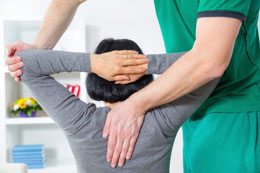Almost everyone experiences pain in the arm and upper back. This pain can be minor or severe. This article provides some information about this condition, its causes, symptoms, and treatment.

Many people experience arm and upper back pain at the same time. It is because the upper back is constituted of arms, shoulders, and neck. The neck is connected to the spinal cord with nerves that further extend to the arms. Overall, the structure is bound together by muscles and ligaments that are the origins of this pain. Some may feel mild and recurrent pain, whereas others may experience severe pain that needs immediate medical attention.
Causes
Arm and upper back pain can be caused due to many reasons. One of the most common causes of pain in the upper arm and upper back is overuse of the neck and upper back muscles, resulting in stress and tightening of the muscles. Hence, people whose occupation requires constant use of their arms in a fixed position such as working on a computer, are usually affected by such a condition. A pinched nerve (nerve root compression) in the lower neck and the upper back portion causes this pain.
Other causes include damage to the spinal cord (spinal trauma), disc injury in the upper back, and improper movement of the joints. Injury in the cervical (near the neck) spine causes pain in the arms and other sensory problems. A disc injury, in the form of a bulge or rupture can lead to back pain. Since the disc acts as a shock absorber and facilitates the smooth movement of the spine, its injury can cause minor to severe back pain. Sometimes, excessive exercise may cause muscle fatigue, resulting in body pain. In addition, a dull lifestyle without exercise and sitting in a wrong posture may cause upper back pain.
Symptoms
Pain in the upper back is the main root that causes arm pain. It is also associated with other symptoms such as:
- Sudden or chronic pain (lasts for more than six months)
- Neck pain
- Pain in the legs and hands
- Sudden stiffness in the neck and arms
- Weakness that makes it difficult for the affected person to perform daily activities
- Numbness
- Stiff muscles (especially in the morning, after waking up)
- Bowel problem
Treatment
Treatment of this condition is necessary, as it may signal the presence of underlying health problems. Also, if the condition remains untreated for an extended period, it can result in other complications such as sciatica, which is a serious problem of the sciatic nerve. However, it is difficult to diagnose the pain as its intensity varies from one person to another. The main objective behind the treatment is to maintain blood circulation and suppleness to the affected area.
Since, a tight muscle in the lower back portion creates pressure in the upper back, one needs to improve the overall blood circulation of the area by doing upper back pain exercises. It is usually done with a series of therapeutic exercises and self-help techniques. Other treatments include chiropractic care, physical therapy, electrical stimulation, hot packs, and cervical traction. The doctor may recommend medications such as pain relievers, cortisone injections, and anti-inflammatory drugs.
Disclaimer:
This Buzzle article is for informative purposes only, and should not be used as a replacement for expert medical advice.


 Many people experience arm and upper back pain at the same time. It is because the upper back is constituted of arms, shoulders, and neck. The neck is connected to the spinal cord with nerves that further extend to the arms. Overall, the structure is bound together by muscles and ligaments that are the origins of this pain. Some may feel mild and recurrent pain, whereas others may experience severe pain that needs immediate medical attention.
Many people experience arm and upper back pain at the same time. It is because the upper back is constituted of arms, shoulders, and neck. The neck is connected to the spinal cord with nerves that further extend to the arms. Overall, the structure is bound together by muscles and ligaments that are the origins of this pain. Some may feel mild and recurrent pain, whereas others may experience severe pain that needs immediate medical attention.